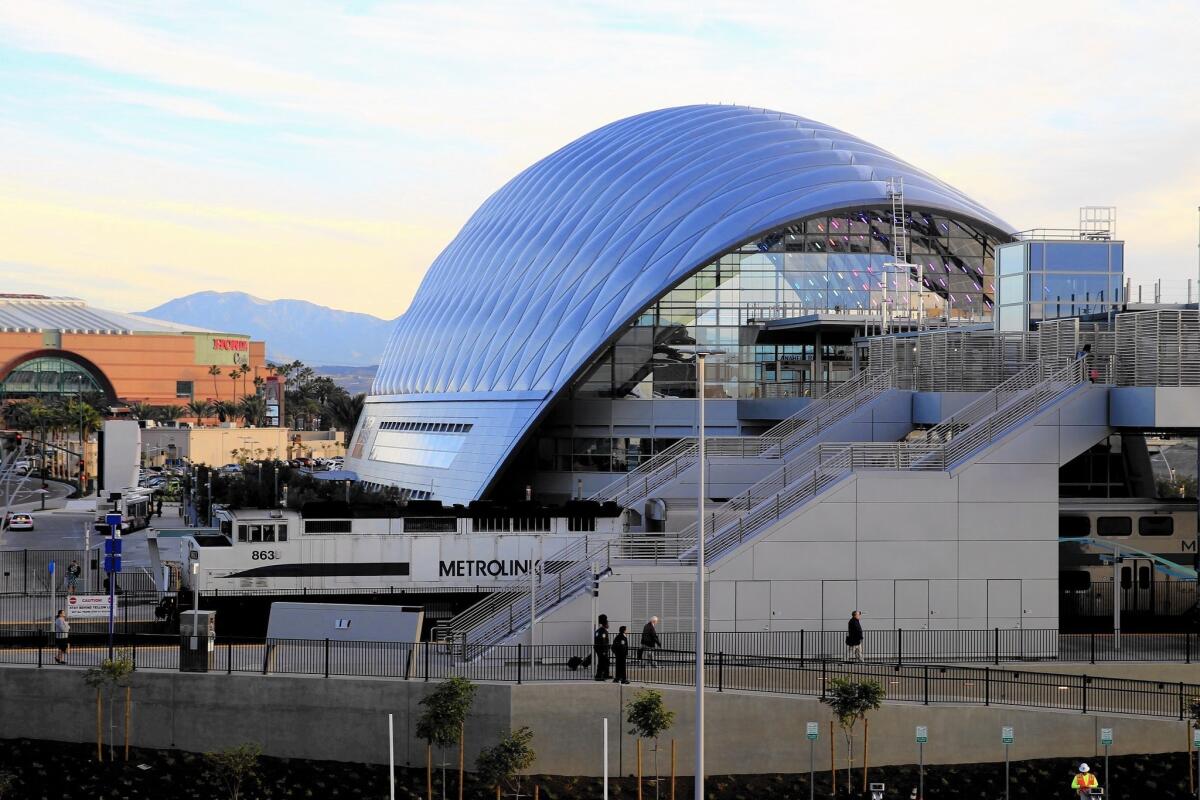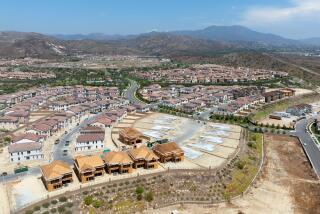Gleaming new transportation hub reflects O.C.’s embrace of public transit

While Los Angeles over the last decade has invested heavily in new rail systems, Orange County has largely kept its eyes on the road — widening freeways, improving traffic flow, building better interchanges.
But this week, commuters got their first view of an enormous, airy transportation hub that reflects Orange County’s growing embrace of public transit.
The $188-million transportation center in the heart of Anaheim, not far from Disneyland, is designed as a central hub where trains, buses, cars and bicycles will converge. Officials hope it ultimately will be the final stop for the state’s proposed high-speed bullet train.
A statement about future
Backers say the aim wasn’t just to create a train station but to also make a statement about the future. They wanted a central station to unite previously scattered transportation services, said Curt Pringle, the former mayor of Anaheim and once board chairman of the California High-Speed Rail Authority.
“It’s planned to be a part of a vibrant community that’s going to grow up around it for a long time,” he said.
The 67,000-square-foot station was two decades in the planning, long enough that the ambitious plans for a countywide light-rail system were drawn up and then shelved. But plans for what was to be Orange County’s premier transportation hub never lost momentum.
The Anaheim Regional Transportation Intermodal Center — ARTIC, for short — sits next to the 57 Freeway, adjacent to the Honda Center and Angel Stadium and a short distance from Disney Resort and the Anaheim Convention Center.
Bus stops for Orange County Transportation Authority routes and private carriers surround the station, while Amtrak and Metrolink trains pick up and drop off passengers on two tracks that passengers reach via a sky bridge.
There are 1,082 parking spaces, a wide circular drive that invites car drop-offs and a dozen bicycle lockers plus additional bike racks.
Progress or ‘boondoggle’
Critics, though, can’t help but point out a missing component. Despite the boasting, the hub so far has no bullet train platform — just a space allocated for it.
“It’s a boondoggle,” said John Moorlach, a county supervisor and an OCTA board member. “It’s just too much building for too little service.”
Although the station is expected to have more than 10,000 daily boardings, the old one-room train depot, tucked in a parking lot beyond center field in Angel Stadium, was only lightly used.
According to OCTA records, the depot had an average of 510 weekday boardings last fiscal year, ranking it seventh among 10 Orange County Metrolink stops. The busiest, Irvine and Fullerton, had three times as many boardings.
The station also ranked third among six Amtrak Pacific Surfliner stops in the county, with 389 average weekday boardings.
All of which causes Supervisor Shawn Nelson, who chairs OCTA’s board of directors, to wonder how the cavernous building will get more people involved in transit.
“There’s a little delusional sort of behavior with this,” he said. “They wanted this so bad they refused to look at some of the realities.”
A soaring design
The station itself is a stunning crisscross of steel pipes that form a rounded skeleton that seems to hover above the ground like a cloud.
Translucent pillows of Teflon-impregnated plastic — the same material used in Beijing’s National Aquatics Center, or Water Cube, and Fisht Olympic Stadium in Sochi, Russia — fill each diamond of the frame, allowing the sun to light 75% of the public space in the building, which is also powered by solar panels.
More than 600 strips of LED lights will turn the pipes red for Angels games and orange when the Ducks play. The teams will have pre- and post-game shows oriented toward the center.
Inside, a large open area faces a main staircase that soars up the building’s three levels, each one recessed from the next. Hot and cold water piped through the floors controls the temperature on each level.
On the ground floor, ticket counters with information on scrolling digital strips await passengers. A “progressive convenience store” and a kiosk offering organic coffee are planned.
Upstairs, restaurants are scheduled to open next year that will offer passengers opportunity to grab a bowl of quinoa and super veggies, watch oysters be shucked, or sip a hand-crafted cocktail at a bar.
Need directions?
Travelers on Monday evening said they were still taking in the spaceship-like building.
“We’re all confused!” said Judith Smith, 61, a rail commuter for 28 years. “I thought I was going into, maybe, the airport.”
Socorro Velasco, 42, who takes the train several times a week from L.A. to her job in Anaheim, said she now has to walk a little farther to get to the depot.
Waiting on a bench outside, she said she thought commuters would like the building once they got used to it. But she wasn’t quite ready to go inside just yet.
“I didn’t want to get lost in there!” she said.
More to Read
Get the Latinx Files newsletter
Stories that capture the multitudes within the American Latinx community.
You may occasionally receive promotional content from the Los Angeles Times.






